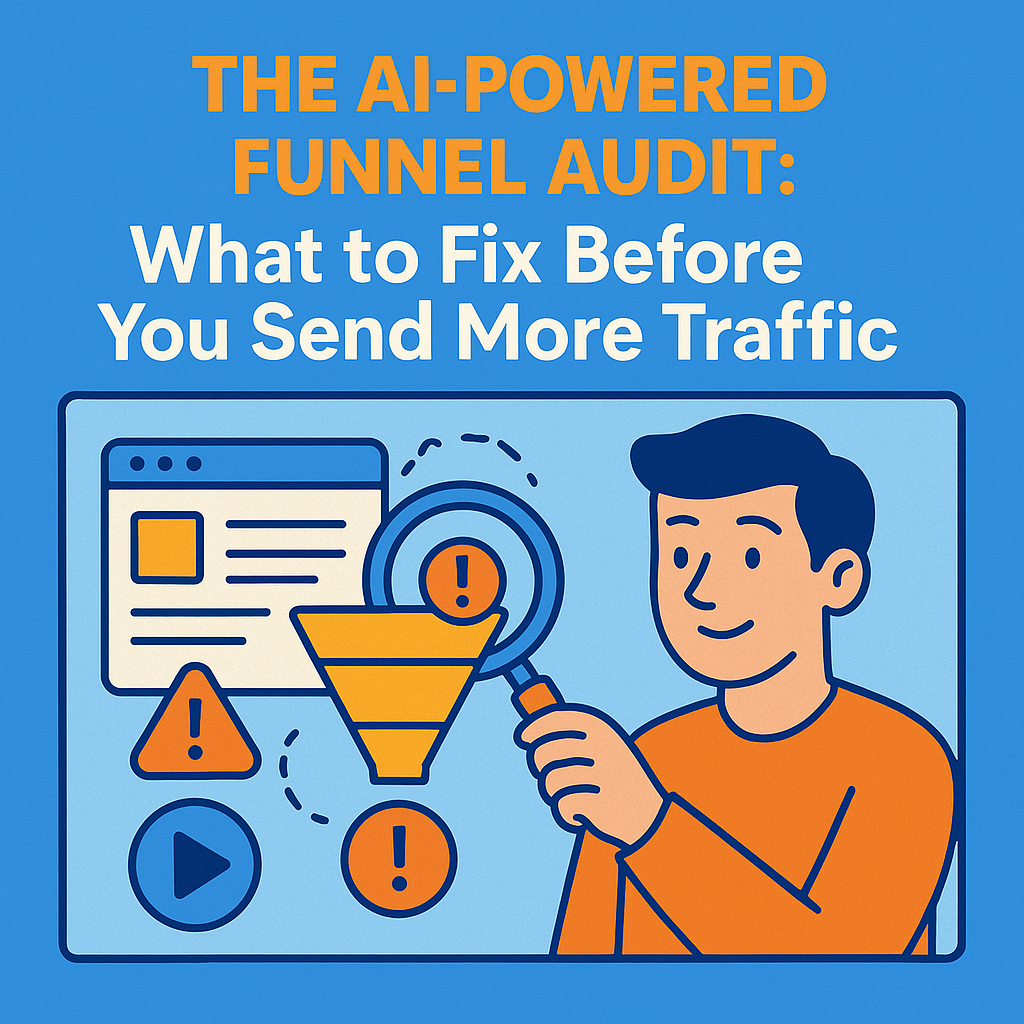Real talk: If your funnel isn’t converting, throwing more traffic at it is like pouring water into a leaking bucket.
Whether you’re running a simple opt-in funnel or a multi-step launch, most marketers make the same mistake — they blame the traffic source when their funnel underperforms. But in reality, it’s usually the funnel itself that’s broken.
Here’s the good news: AI makes it ridiculously fast to audit and fix your funnel — before you waste time, ad spend, or energy.
In this post, we’ll break down exactly how to use AI to:
- Audit every stage of your funnel (landing pages, emails, sales pages, and more)
- Spot conversion killers instantly
- Fix weak copy and UX issues using smart GPT prompts
- Create a repeatable process that improves every funnel you launch
Why Funnels Fail — and How AI Helps
Most funnel failures fall into a few brutal but fixable categories:
|
Problem |
Impact |
|
Weak headlines or unclear value |
Low opt-in rates |
|
Irrelevant or robotic email copy |
Poor engagement |
|
Generic or bloated sales pages |
No conversions |
|
CTA misalignment |
Clicks but no action |
|
Lack of urgency or trust |
Stalled decision-making |
Traditional fixes take days. You A/B test. You rewrite copy. You stress-scroll other funnels.
AI changes the game.
With the right prompts, AI can spot these issues and suggest improvements in minutes — giving you an edge before you send a single click.
The AI-Powered Funnel Audit Framework
Here’s how to run a complete funnel audit using ChatGPT (or a similar AI assistant). Use this checklist for each stage of your funnel.
✅ Stage 1: Landing Page Audit
Goal: Maximize opt-ins by making your value instantly clear.
What AI Should Check:
- Headline clarity and power
- Subheadline specificity
- Lead magnet appeal
- Visual hierarchy
- CTA button copy
Try This Prompt:
“Act as a funnel conversion expert. Here’s my landing page copy. Identify anything that might reduce opt-ins and suggest 3 variations of my headline and CTA.”
Pro tip: Paste in just the text first — no design needed. You can then iterate the layout separately.
Fix Checklist:
- Is the headline benefit-focused, not feature-based?
- Does the subheadline answer: “Why now?”
- Is the lead magnet urgent, useful, and easy to consume?
- Is the CTA action-driven? (e.g., “Get My Free Checklist” > “Submit”)
✅ Stage 2: Thank You / Confirmation Page Audit
Goal: Use momentum to increase engagement or move to next step.
What AI Should Check:
- Is the next action clear?
- Is there a soft offer or “tripwire” missing?
- Does the tone feel personal?
Try This Prompt:
“Here’s my thank-you page text. Suggest how I can improve the copy to increase click-throughs to my next funnel step.”
Fix Checklist:
- Did you plant a seed for the next step?
- Do you offer a bonus, surprise, or low-ticket upgrade?
- Can you include a testimonial or short video?
✅ Stage 3: Email Sequence Audit
Goal: Build trust, reinforce pain/desire, and drive action.
What AI Should Check:
- Subject lines for curiosity and clarity
- Tone (robotic vs conversational)
- Logical sequence and value progression
- Gaps in urgency, scarcity, social proof
Try This Prompt:
“Review this 5-email welcome sequence. For each email, suggest improvements to increase opens and clicks. Also flag any areas that feel too generic.”
Upgrade prompt:
“Rewrite Email 3 with more storytelling and emotional engagement, targeted at [audience type].”
Fix Checklist:
- Is each email one purpose, one call to action?
- Are you alternating logic + emotion?
- Is your offer slowly being introduced, not pitched on email #1?
✅ Stage 4: Sales Page Audit
Goal: Turn attention into belief and belief into action.
What AI Should Check:
- Does the hero section punch hard?
- Are objections addressed?
- Is there a clear problem-solution bridge?
- Does the CTA repeat and escalate?
Try This Prompt:
“Act as a copywriter for high-ticket offers. Review this sales page and suggest 3 emotional hooks I could use to rewrite the hero section.”
“List 5 common objections my reader may have and write FAQ-style answers that could appear mid-page.”
Fix Checklist:
- Does the hero section make it impossible to look away?
- Is there a customer story or use case near the top?
- Do you sprinkle testimonials strategically, not all at the bottom?
- Does your offer include bonus stacking, value contrast, and urgency?
✅ Stage 5: Funnel Journey Audit
Goal: Ensure every step leads smoothly into the next with no leaks or logic gaps.
What AI Should Check:
- Is there a disconnect between entry point and end offer?
- Do transitions make sense emotionally and logically?
- Is there drop-off data (email open/click) that indicates friction?
Try This Prompt:
“Map the logic flow of this funnel. Does the lead magnet, emails, and sales page all align with the same promise and audience pain point?”
Fix Checklist:
- Are you solving the same core problem across all steps?
- Does your lead magnet set up the pitch?
- Are readers constantly reminded why this matters now?
Bonus: Full Funnel Audit Prompt Stack (Copy/Paste)
Use this once you have all your funnel assets together.
“Act as a direct-response funnel optimization consultant. I’m going to give you my landing page, emails, and sales page. Point out any areas where messaging, tone, or strategy are misaligned — and suggest specific improvements to increase conversion at each stage.”
Case Study: From 8% to 24% Opt-In Rate Using AI Copy Fixes
One of our readers used this audit flow to improve their opt-in funnel for a webinar offer. After pasting in their headline and lead magnet into ChatGPT, they realized:
- The headline was passive (“Learn how to…”)
- The lead magnet felt too generic
- The CTA button was weak (“Get Access”)
They swapped in:
- A benefit-driven headline with emotional pull
- A faster, outcome-based lead magnet title
- A CTA that implied urgency and ease (“Start Learning in 5 Minutes”)
Result? Opt-in rate jumped from 8% to 24%.
The whole fix took 35 minutes — including testing 3 AI variations.
Final Thoughts: Don’t Optimize Blind
Funnels that convert aren’t built in one shot. They’re audited, tweaked, and tested repeatedly — and AI helps you shortcut that cycle dramatically.
Before you run ads or pour more traffic into a funnel, run an AI audit:
- It costs nothing.
- It surfaces blind spots.
- It gives you angles you can act on now.
When used strategically, AI isn’t just a writing tool — it’s a marketing mirror that shows you where your funnel is failing to communicate or convert.
✍️ Your Next Step:
✅ Run your own funnel audit using the prompts above
✅ Save the suggestions that resonate
✅ Test small changes and track the impact
Want to make this even easier? Download the AI Funnel Audit Prompt Pack and plug it into your workflow.



